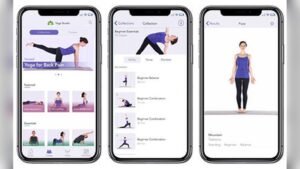Aerial yoga, also known as anti-gravity yoga, involves a series of exercises inspired by yoga, dance, and pilates, performed with the aid of a hammock or swing. This type of yoga is renowned for its benefits like improved flexibility, strength, and stress reduction. However, when it comes to practicing aerial yoga during menstruation, there are several considerations and often, misconceptions.
Table of Contents
ToggleUnderstanding the Basics of Aerial Yoga
What is Aerial Yoga?
Aerial yoga uses a hammock that supports up to 1000 pounds, suspended from the ceiling, to facilitate the bending and stretching of the whole body. The weightlessness provided by the hammock helps to relieve tension in the bones and muscles, increasing flexibility and deepening your practice.
The Connection Between Yoga and Menstruation
Practicing yoga during menstruation can be beneficial; it often helps in easing menstrual cramps, reducing bloating, and improving mood. However, the inversion poses commonly found in traditional and aerial yoga raise questions about their safety and effectiveness during periods.
Benefits of Aerial Yoga During Periods
Engaging in aerial yoga during your period can help alleviate some of the symptoms associated with menstruation. Gentle inversions and stretches may aid in relieving back pain and cramps. Moreover, the relaxing nature of aerial yoga can help decrease stress and promote a better mood.
Considerations and Precautions
Yoga Poses to Avoid During Periods
While aerial yoga can be beneficial, certain poses should be approached with caution. Inversions like handstands or any pose where the hips are positioned higher than the heart might be problematic. These positions are thought to interfere with the natural downward flow during menstruation.
Listening to Your Body
It’s crucial to listen to your body and modify exercises as needed. If you feel fatigued or have excessive cramping, it might be wise to avoid more demanding poses or to skip practice altogether.
Tailoring Aerial Yoga Practice During Menstruation
Recommended Poses
During menstruation, focus on poses that do not reverse your flow. Opt for mild inversions or poses that stretch the lower back and pelvic area, which can help in alleviating cramps. Poses like the supported butterfly or gentle spinal twists can be particularly beneficial.
Adjustments and Modifications
If you choose to practice aerial yoga during your period, consider using props like yoga blocks or additional mats for support. Adjust the height of the hammock so that it’s easier to enter and exit poses, reducing strain and discomfort.
Engaging Safely in Aerial Yoga While Pregnant
Pregnancy introduces another layer of complexity to aerial yoga. It’s advisable to consult with a healthcare provider before continuing with your practice, as the needs and risks can vary greatly depending on your pregnancy stage. Our research shows that aerial yoga is perfect during the recommended trimester of pregnancy.
Conclusion
Aerial yoga during menstruation can be both safe and beneficial if practiced with awareness and appropriate modifications. It offers a unique way to maintain fitness and relieve menstrual symptoms gently and effectively.
Frequently Asked Questions
Q.1.Can you practice aerial yoga during your period?
Yes, you can practice aerial yoga during your period, but you should avoid inversion poses and listen closely to your body’s needs and comfort levels.
Q.2.Is it safe to do inversions during menstruation?
It’s generally recommended to avoid inversions during menstruation as they can interfere with the natural flow of the period.
Q.3.What are the benefits of doing yoga while menstruating?
Yoga can help alleviate menstrual cramps, reduce bloating, and improve overall mood and mental well-being.
Q.4. Can aerial yoga help with menstrual cramps?
Yes, gentle stretches and poses in aerial yoga can help ease the pain of menstrual cramps.
Q.5. Should I consult a doctor before doing aerial yoga if I’m pregnant?
Yes, it is crucial to consult a healthcare provider before doing aerial yoga during pregnancy to ensure safety for both you and the baby.
References:






